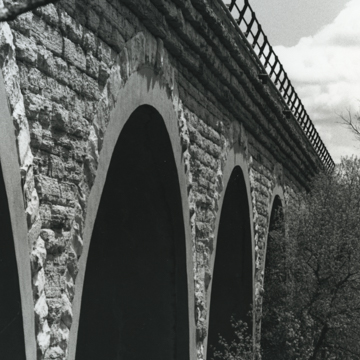This railroad viaduct over Turtle Creek is one of Wisconsin’s few surviving stone bridges. Known locally as Tiffany Bridge, after a hamlet just to the north, it is a magnificent structure, 387.5 feet long, built of quarry-faced limestone blocks. Each of its five arches spans 50 feet and has a radius of 26.5 feet. John Watson, a contractor in Janesville who specialized in bridges and tunnels, built the span according to plans developed by the railway company’s chief engineer, a man known now only by his surname, van Mienen. The rugged stone used in the spandrels of the arches was quarried near Waupun and Green Bay and sent rough to the site, where workers cut it by hand. A corbeled cornice—four stepped courses of limestone blocks, topped by a stone cap—surmounts the arches. The piles below the limestone piers are battered on the downstream side to resist the force of the water’s flow. Upstream, they are deeply offset to resist the lateral pressure of the creek. The arches were reinforced with steel rods and concrete in the 1930s, enabling the bridge to bear the weight of modern locomotives that weigh nearly six times more than steam engines did in 1869.
You are here
Tiffany Stone Bridge (Chicago and North Western Railway Bridge No. 128)
c. 1869, van Mienen, engineer; John Watson, builder. Across Turtle Creek. Best viewed from Turtle Creek Pkwy, 6528 S. Smith Rd.
If SAH Archipedia has been useful to you, please consider supporting it.
SAH Archipedia tells the story of the United States through its buildings, landscapes, and cities. This freely available resource empowers the public with authoritative knowledge that deepens their understanding and appreciation of the built environment. But the Society of Architectural Historians, which created SAH Archipedia with University of Virginia Press, needs your support to maintain the high-caliber research, writing, photography, cartography, editing, design, and programming that make SAH Archipedia a trusted online resource available to all who value the history of place, heritage tourism, and learning.







